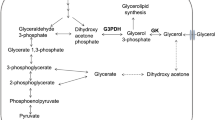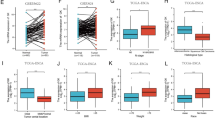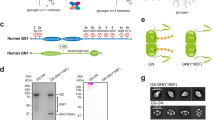Abstract
Four unrelated patients with glyceroluria ranging from 7 to 170 mmol/l were studied. The activity of glycerol kinase (GK) in cultured fibroblasts was determined with a specific enzyme assay and with two indirect methods, that is, incorporation into macromolecules of [14C] from [14C]glycerol and its oxidation to [14C]CO2. Exon amplification and RT-PCR were used to identify mutations. In patient 1, with low activity in all three assays, we identified a c.1194A>C (E398D) missense mutation. In patient 2 with a considerable activity of the GK enzyme (22% of reference), oxidation to [14C]CO2 (37%) and a high incorporation of [14C] into macromolecules (92%), we identified a c.182T>C (L61P) mutation that causes the enzyme to have a higher Km for glycerol (∼300 μ M) than normals (2–8 μ M). In patient 3, the GK activity estimated by the three different methods ranged from 16 to 22% of reference. Analysis of mRNA from the GK gene revealed three alternatively spliced transcripts. A mutation in intron 3 (g.16835G>A) resulted in an insertion of a cryptic exon between exon 2 or 3 and exon 4. Patient 4 with minor glyceroluria (7 mmol/l) and normal plasma glycerol concentration had normal activity with all three assay methods, thus excluding GK deficiency (GKD) as a cause of slight glyceroluria. To evaluate fully patients with glyceroluria, one needs to measure the GK activity and relate this and the clinical data to genetic findings. Residual enzyme activities in cultured fibroblasts can be found in GKD patients with severe clinical symptoms.
Similar content being viewed by others
Log in or create a free account to read this content
Gain free access to this article, as well as selected content from this journal and more on nature.com
or
References
Sjarif DR, Sinke RJ, Duran M et al: Clinical heterogeneity and novel mutations in the glycerol kinase gene in three families with isolated glycerol kinase deficiency. J Med Genet 1998; 35: 650–656.
Hellerud C, Wramner N, Erikson A, Johansson Å, Samuelson G, Lindstedt S : Glycerol kinase deficiency; follow-up during 20 years, genetics, biochemistry, and prognosis. Acta Paediatr, In Press.
McCabe ERB : Disorders of glycerol metabolism; in Scriver CR, Beaudet AL, Sly WS, Valle D (eds): The Metabolic and Molecular Bases of Inherited Disease, 8th edn. New York: McGraw-Hill; 2001, pp 2217–2237.
Scheuerle A, Greenberg F, McCabe ER : Dysmorphic features in patients with complex glycerol kinase deficiency. J Pediatr 1995; 126: 764–767.
Rose CI, Haines DS : Familial hyperglycerolemia. J Clin Invest 1978; 61 (1): 163–170.
Blomquist HK, Dahl N, Gustafsson L et al: Glycerol kinase deficiency in two brothers with and without clinical manifestations. Clin Genet 1996; 50: 375–379.
Hellerud C, Burlina A, Gabelli C, Ellis JR, Nyholm PG, Lindstedt S : Glycerol metabolism and determination of triglycerides - clinical biochemical and molecular findings in six subjects. Clin Chem Lab Med 2003; 41 (1): 46–55.
McCabe ER, Sadava D, Bullen WW, McKelvey HA, Seltzer WK, Rose CI : Human glycerol kinase deficiency: enzyme kinetics and fibroblast hybridization. J Inherit Metab Dis 1982; 5: 177–182.
Dipple KM, Zhang YH, Huang BL et al: Glycerol kinase deficiency: evidence for complexity in a single gene disorder. Hum Genet 2001; 109: 55–62.
Sargent CA, Kidd A, Moore S, Dean J, Besley GT, Affara NA : Five cases of isolated glycerol kinase deficiency, including two families: failure to find genotype:phenotype correlation. J Med Genet 2000; 37: 434–441.
Zhang Y, Dipple KM, Vilain E et al: AluY insertion (IVS4-52ins316alu) in the glycerol kinase gene from an individual with benign glycerol kinase deficiency. Hum Mutat 2000; 15: 316–323.
Sjarif DR, Dorland L, Sperl W et al: Hyperketonaemia in glycerol kinase deficiency. J Inherit Metab Dis 2000; 23: 760–764.
Bonnefont JP, Specola NB, Vassault A et al: The fasting test in paediatrics: application to the diagnosis of pathological hypo- and hyperketotic states. Eur J Pediatr 1990; 150: 80–85.
Malunowicz EM, Mitkowska Z, Bal K et al: Definitive diagnosis of enzymatic deficiencies of steroidogenesis in at-risk newborns and infants by urinary marker analysis using GC/MS-SIM. Horm Res 1997; 48: 243–251.
Bachmann C : Diagnosis of urea cycle disorders. Enzyme 1987; 38: 233–241.
Lowry OH, Rosebrough NJ, Farr AL, Randell RJ : Protein measurement with the Folin phenol reagent. J Biol Chem 1951; 193: 265–275.
Sargent CA, Young C, Marsh S, Ferguson Smith MA, Affara NA : The glycerol kinase gene family: structure of the Xp gene, and related intronless retroposons. Hum Mol Genet 1994; 3: 1317–1324.
Bertina RM, Ploos van Amstel HK, van Wijngaarden A et al: Heerlen polymorphism of protein S, an immunologic polymorphism due to dimorphism of residue 460. Blood 1990; 76: 538–548.
Yanase T, Takayanagi R, Oba K, Nishi Y, Ohe K, Nawata H : New mutations of DAX-1 genes in two Japanese patients with X-linked congenital adrenal hypoplasia and hypogonadotropic hypogonadism. J Clin Endocrinol Metab 1996; 81: 530–535.
den Dunnen JT, Antonarakis SE : Nomenclature for the description of human sequence variations. Hum Genet 2001; 109: 121–124.
Hellerud C, Adamowicz M, Jurkiewicz D et al: Clinical heterogeneity and molecular findings in five polish patients with glycerol kinase deficiency; investigation of two splice site mutations with computerized splice junction analysis and Xp21 gene specific mRNA analysis. Mol Genet Metab 2003; 79: 149–159.
Hurley JH, Faber HR, Worthylake D et al: Structure of the regulatory complex of Escherichia coli IIIGlc with glycerol kinase. Science 1993; 259: 673–677.
Walker AP, Muscatelli F, Stafford AN et al: Mutations and phenotype in isolated glycerol kinase deficiency. Am J Hum Genet 1996; 58: 1205–1211.
Schneider TD : Information content of individual genetic sequences. J Theor Biol 1997; 189: 427–441.
Thompson TE, Rogan PK, Risinger JI, Taylor JA : Splice variants but not mutations of DNA polymerase beta are common in bladder cancer. Cancer Res 2002; 62: 3251–3256.
Jin H, Gardner RJ, Viswesvaraiah R, Muntoni F, Roberts RG : Two novel members of the interleukin-1 receptor gene family, one deleted in Xp22.1–Xp21.3 mental retardation. Eur J Hum Genet 2000; 8: 87–94.
Romero NB, Recan D, Rigal O et al: A point mutation in the glycerol kinase gene associated with a deletion in the dystrophin gene in a familial X-linked muscular dystrophy: non-contiguous gene syndrome involving Becker muscular dystrophy and glycerol kinase loci. Neuromuscul Disord 1997; 7: 499–504.
Kohlschütter A, Seitz HJ, Feldmann B, Lehnert W, Langenbeck U : Glyceroluria in healthy adults, mentally ill adults and children selected for metabolic screening. Clin Chim Acta 1991; 15: 203–207.
Guo W, Worley K, Adams V et al: Genomic scanning for expressed sequences in Xp21 identifies the glycerol kinase gene. Nat Genet 1993; 4: 367–372.
Acknowledgements
DRS, pediatrician, is a staff member of the Department of Child Health, Dr Cipto Mangunkusumo National General Hospital, University of Indonesia – School of Medicine, Jakarta, Indonesia. She is recipient of a grant from the Van Deventer-Maas Foundation, The Netherlands. We acknowledge the technical assistance of Mr PHA van Zon in DNA mutation analysis, Mr VH Garritsen for [14C]glycerol incorporation studies, Dr Isabelle Vernhet (Department of Medical Genetics and Metabolic Disease, CHU Pellegrin, Bordeaux, France) and Dr Wolfgang Getzner (Zentrallabor, Universitätskliniken Innsbruck, Austria) for glycerol analysis in the urine of patients 1 and 2, respectively, and Dr James R Ellis (Division of Bioengineering and Physical Sciences, Office of Research Services, National Institute of Health, Bethesda, USA) for performing the splice site analysis.
Author information
Authors and Affiliations
Corresponding author
Rights and permissions
About this article
Cite this article
Sjarif, D., Hellerud, C., Amstel, J. et al. Glycerol kinase deficiency: residual activity explained by reduced transcription and enzyme conformation. Eur J Hum Genet 12, 424–432 (2004). https://doi.org/10.1038/sj.ejhg.5201172
Received:
Revised:
Accepted:
Published:
Issue date:
DOI: https://doi.org/10.1038/sj.ejhg.5201172
Keywords
This article is cited by
-
A rare co-occurrence of duchenne muscular dystrophy, congenital adrenal hypoplasia and glycerol kinase deficiency due to Xp21 contiguous gene deletion syndrome: case report
BMC Endocrine Disorders (2021)
-
Reflection of treatment proficiency of hydroxyurea treated β-thalassemia serum samples through nuclear magnetic resonance based metabonomics
Scientific Reports (2019)
-
β-Thalassemia Patients Revealed a Significant Change of Untargeted Metabolites in Comparison to Healthy Individuals
Scientific Reports (2017)



